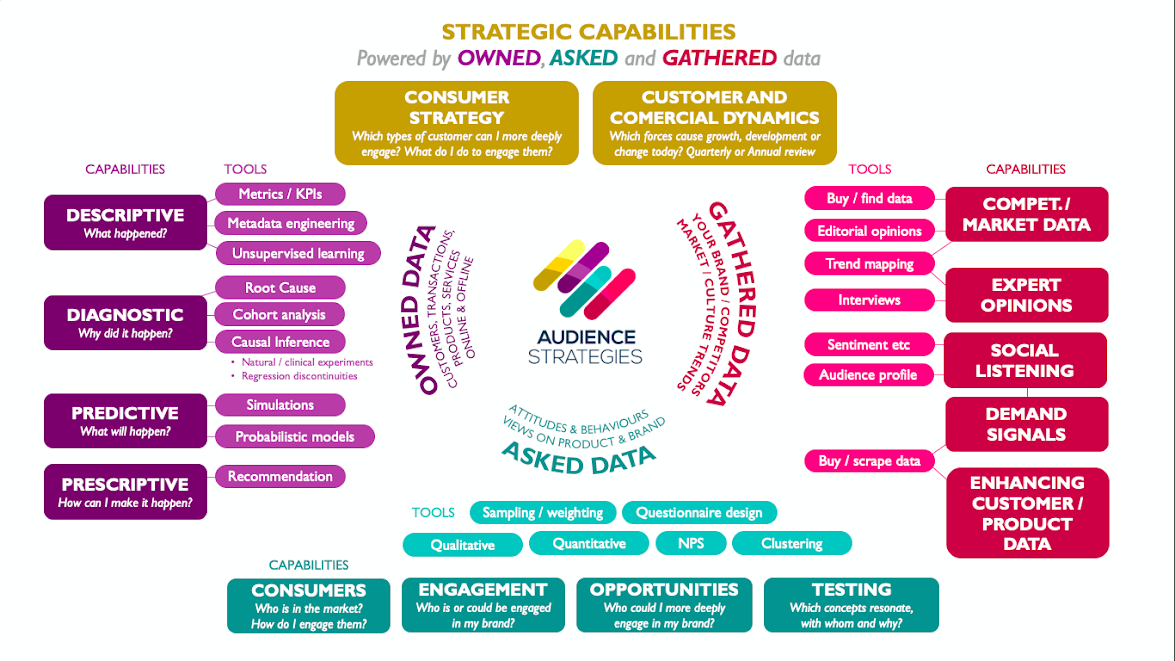The social market research renaissance
This article was originally published as a collaboration in the Better, Faster, Cheaper Customer Insight report, by The Social Intelligence Lab.
The convergence between digital and traditional in all aspects of marketing has given way to a more strategic and holistic vision of business activity. This, together with a better understanding and use of the available data, is turning businesses to a paradigm in which data and insights are a fundamental pillar of the development of activity to become insights-driven companies.
Some authors have alluded to the beginning of a social market research renaissance and I share that view. Nevertheless, to understand where researchers can delve deeper into customer insight using digital consumer intelligence, it is important to differentiate the source of the data.
One of the most comprehensive descriptions of types of data and the strategic capabilities of “digital consumer intelligence” is the one provided in the image below by audience strategist consultant David Boyle. As well as working out the data types, Boyle also highlights the importance of differentiating between consumer vs customer vs audience:
“Why 'audience' and not 'customers'? Some of the people you design for and need to communicate with may be direct customers, but many others likely appreciate your brand from afar and are better thought of as an audience rather than as customers (...yet).”

Independently of the data source, researchers can go deeper with digital consumer intelligence by:
- Taking advantage of the increased speed with which technology can now gather, classify and visualize data allowing to test more hypotheses to arrive at the right answer quicker.
- Making use of Connecting platforms to widen audience knowledge. With the wide range of tools out there we are able to build upon the connections we see forming, helping to create a deeper understanding.
Someone who truly understands how the nature of insights is source dependant is Edward James Bass, founder and director at EntSight. During an event we co-hosted in London last year, Edward shared some of his work with Social and Survey data to present his discovery and validate what he has termed “vital human insights”. Which he defines as the learnings about audiences used to inform decision making and strategic direction.
He states:
“No one ever shared a tweet which clearly outlined their customer journey when buying a holiday, since that is about as likely as a survey containing a range of responses to cover the whole myriad of topics an audience might talk about online. With this in mind, I strongly recommend that when looking to understand a particular aspect of an audience that analysts consider which tool is best for the task.”
The most fertile source for insights
Social Data, as a data source, is particularly prolific when trying to understand the thought process of a consumer. At the same event, the consumer psychologist Nisa Bayindir reiterated the essential point:
“Social media data is still the most fertile source for quick and valuable insights into the ‘mind’ of the consumer.”
At Audiense, we have seen this type of use from hundreds of brands using our platform. Something we have learned is that Twitter data is specifically unique for understanding:
- The interconnected communities of a particular audience or a conversation.
- The affinity towards bands or influencers of these communities.
- The ability to compare this information with any other benchmark.
These insights must be correlated with other sources for validation and context. Michael Brito, EVP, Digital & Analytics at Zeno Group, who has wide ranging experience in working with social data to understand audience behaviour, refers to specific examples where social intelligence and digital consumer insights fit into customer insights such as persona development, content marketing, influencer marketing and sponsorships. Taken from his article “3 Reasons Why Audience Intelligence Should be a Priority in 2020”, he puts things into context.
“2019 was filled with buzz about data-driven storytelling. While it’s good that marketers and pundits are thinking more about data, it’s clear that there’s more work to do. Social listening, performance media and web analytics are top of mind but the missing piece is audience. When I refer to audience, I mean studying and analyzing real people–their interests, characteristics and media habits that make them unique. This way of thinking about analytics is the real disruption.”
Are we prepared for a cookie-less world?
We only seem to reaffirm that in the coming ‘cookie-less world’, creativity and audience-first marketing are at the heart of the solution. Indeed, Nielsen has always cited the ‘Creative’ as the main reason for why advertising campaigns are successful (47%), way above Targeting (9%). Moreover, Forrester’s Rusty Warner predicts that Content will challenge the crown position of Data management & Analytics, when it comes to brand priorities.
In this sense, many companies have fallen into what David Boyle calls “the personalization trap” in his article in The Most Contagious Report 2019:
“Many companies fall into the personalisation trap of perfecting tactical optimisation at the expense of strategic guidance and they miss out on growth opportunities as a result. But with the right tools, strategic guidance in the form of an audience strategy can be easy to achieve. We find that clustering consumers according to needs will quickly get you a long way towards a good audience strategy.”
We believe this change is for the better and allows brands to be truly audience-first, and put creativity and audience marketing back at the heart of the strategy.
Photo by Pablo Orcaray on Unsplash.







